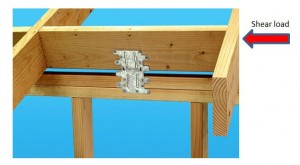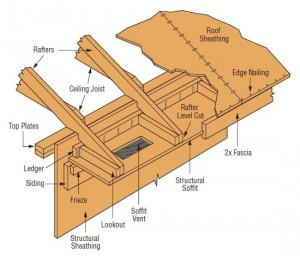How To Install Blocking Between Rafters
Blocking or boundary member?
In my experience traveling beyond the country observing wood-framed structure, it was credible that east of the Rocky Mountains, structural woods members in-line with supporting walls betwixt roof framing terminate to be installed. Some may telephone call these forest members blocking and deem them as optional. And often in a humid environment, installation of these members may be ardently resisted in lodge to provide ample attic ventilation and prevent mold growth. It is of import, even so, to understand that this blocking creates the structural boundary members for the roof diaphragm and it is not optional.
Tabulated allowable diaphragm lateral design loads contained in the building lawmaking, are based on testing of unblocked and blocked diaphragms (structural wood members used at intermediate capsule edges to increment the shear load in the diaphragm). In all cases a boundary fellow member effectually the perimeter of the diaphragm, where the shear is the highest, was utilized. The purlieus member in these tested assemblies was a minimum 2x structural member that collected the load from the diaphragm through the fasteners in the edge of the diaphragm. When a boundary member is missing, what other central chemical element is also missing? That'south right, the fasteners! If a diaphragm purlieus member and consequently capsule fasteners are omitted, a weakened and unknown commanded roof diaphragm lateral load volition exist.
Example
If the roof framing is spaced at 24 inches on eye in the motion picture beneath, what is the fastener spacing in the direction of the shear load if there is no boundary member? Yes, pretty easy, 24 inches on middle. So what is the diaphragm commanded load with fasteners spaced at 24 inches on eye? The reply is unknown.

In addition to existence a required structural member, the boundary member can be a big benefit when installed. There is an obvious direct connexion between the roof diaphragm and lateral resisting organization below (typically shearwalls) to transfer shear loads. Hurricane ties may be an alternative to transfer shear between the roof and wall, but the use of these connectors does not negate the need for the boundary member. Installing a boundary member will require boosted detailing to attain the needed ventilation without compromising the structural integrity of the roof diaphragm.
Ventilation
Acceptable attic ventilation can be developed through other detailing similar holes and screens in the purlieus member, orienting every third member horizontal, or gable terminate vents; merely cannot exist a reason for eliminating the diaphragm purlieus member.
One possible method to eliminate the purlieus fellow member in-line with the wall below may be to soffit the eaves and provide a structural fascia board that will receive the diaphragm fasteners. Proper detailing, like shown beneath, and a structural soffit will exist required to adequately transfer the shear in this method.

What are your thoughts? Let me know in the comments.
– Paul
What are your thoughts? Visit the weblog and get out a comment!

Source: https://seblog.strongtie.com/2012/10/why-a-structural-boundary-member-between-a-trussrafter-is-not-optional/
Posted by: statonnookin.blogspot.com


0 Response to "How To Install Blocking Between Rafters"
Post a Comment